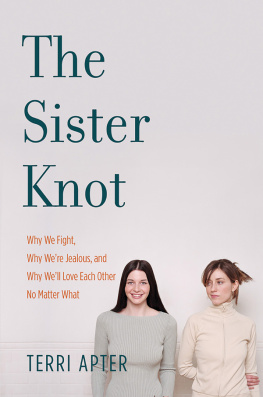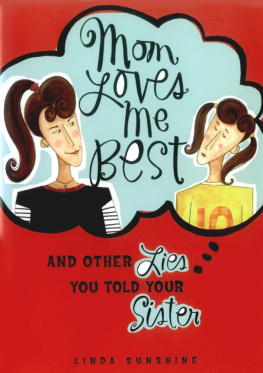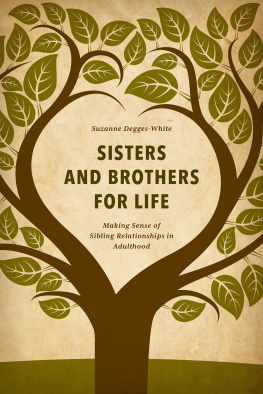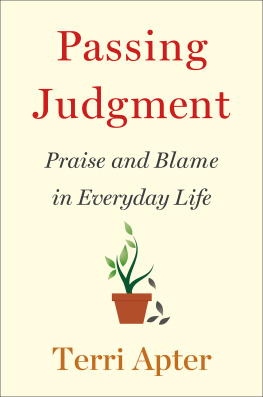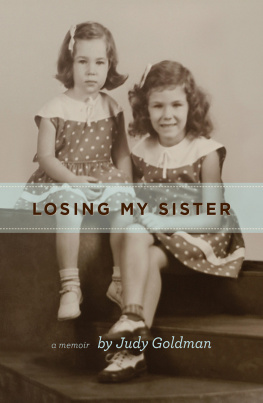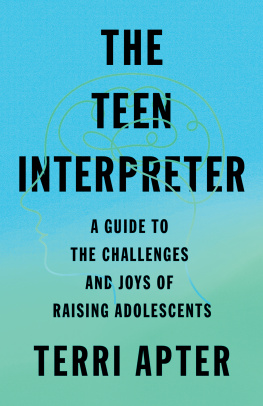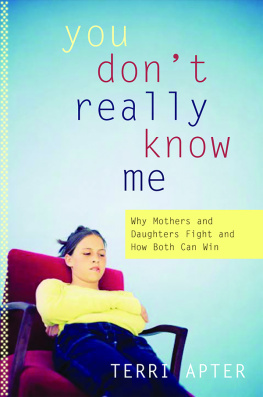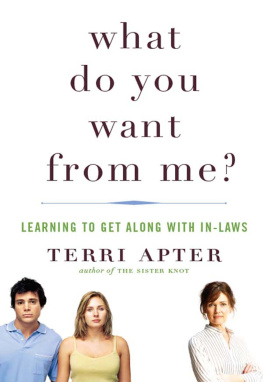
ALSO BY TERRI APTER
The Confident Child: Raising Children to Believe in Themselves
Secret Paths: Women in the New Midlife
Best Friends: The Perils and Pleasures of Girls and
Womens Friendships (Ruthellen Josselson, coauthor)
Altered Loves: Mothers and Daughters During Adolescence
Working Women Dont Have Wives: Professional Success in the 1990s
The Myth of Maturity:
What Teenagers Need from Parents to Become Adults
You Dont Really Know Me:
Why Mothers and Daughters Fight and How Both Can Win
THE SISTER KNOT

WHY WE FIGHT,
WHY WERE JEALOUS,
AND WHY
WELL LOVE EACH OTHER
NO MATTER WHAT

TERRI APTER

Copyright 2007 by Terri Apter
All rights reserved
First Edition
For information about permission to reproduce selections from this book, write to Permissions, W. W. Norton & Company, Inc., 500 Fifth Avenue, New York, NY 10110
Book design by Brooke Koven
Production manager: Julia Druskin
The Library of Congress has cataloged the printed edition as follows:
Apter, T. E.
Sister knot : why we fight, why were jealous, and why well love
each other no matter what / Terri Apter. 1st ed.
p. cm.
Includes bibliographical references and index.
ISBN-13: 978-0-393-06058-4 (hardcover)
ISBN-10: 0-393-06058-6 (hardcover)
1. Sisters. I. Title.
BF723.S43A67 2007
306.8754dc22
2006024657
ISBN 978-0-393-33062-5
ISBN 978-0-393-28576-5 (e-book)
W. W. Norton & Company, Inc., 500 Fifth Avenue, New York, N.Y. 10110
www.wwnorton.com
W. W. Norton & Company Ltd., Castle House, 75/76 Wells Street, London W1T 3QT
To my sister, Marion,
and my favorite sister pair,
Miranda and Julia
CONTENTS
Younger Sisters and Other Variations:
Why the Sibling Trauma Is Universal
Just Like and Completely Different:
How Sisters Find and Resist Family Roles
This book is rooted in the idea that close relationships develop throughout our lifetimes. Any exploration of these patterns of development requires generous participation of people whose relationships are being recorded. Hence my first and greatest debt is to the girls and women who spoke to me about their sisters, who accommodated me in their sister groups, who ferreted out old diaries and memories, who revealed the complicated feelings that drove them apart and bound them together.
Intellectually, I owe a great deal to Juliet Mitchell, whose vision of siblings role in the formation of the psyche has influenced my management of material. I have also been encouraged by her warm response to the use I have made of her groundbreaking work. Carol Gilligan helped me think through the ramifications of the sister knot in the complicated sphere of female friendships. Rebecca Kilner introduced me to fascinating studies of sibling behavior from a zoologists perspective, including her own creative readings of sibling rivalry and cooperation in cowbirds. Helaine Blumenfeld highlighted the ways that having or not having a sister could lead to different friendship glitches. Anna Baldwin was always an active listener, careful to ensure that I combined theory and example. Colleagues at Newnham, in particular Liba Taub and Claire Hughes, guided me to examples and theories I would otherwise have missed. Michelle Spring and Daphne Wright, with their distinctive slants as thriller writers, each highlighted the warmth and the terror of these bonds. Soulla Pourgourides generous excitement about the topic also helped to nudge a musing into a project.
My editor, Jill Bialosky, and my agent, Meg Ruley, have for many years been encouraging forces behind this book, so I feel that what developed is a team effort.
THE SISTER KNOT
W HEN I WAS a child I was burdened by a secret that seemed to me at once strange and normal. The secret consisted of two parts: First, there were times when I loved my sister more than anyone else, even more than I did my parents. Though the bond had both a ferocity and a comfort I found nowhere else, it had no place in the familiar language about family attachment. The link I forged with my sister made me feel off center, even guilty, because it was outside all we had been taught about the pecking order of love. Honoring, respecting, and obeying parents were high on the list of moral injunctions, but bonding with, caring for, and appreciating ones sister were never cited in the rule book. Yet I thought about these issues daily, as my sister comforted me, rebuffed me, and presented herself as both an ally and a competitor.
Second, I knew that I often felt toward my sister something very different from love. It was overpowering, and it was awful. I eventually learned to give it the name envy, but it was different from the portrayal of envy in TV soaps and in childrens stories, in which envy was felt by nasty girls toward nice ones. The envy I experienced consisted of panic and of emptiness. My sisters virtues and talents called up love and admiration; they also slapped me hard, left me stunned, my head buzzing within a vast emptiness. This added to my guilt, because in its grip I felt capable of destroying the person I felt I loved most.
The special nature of sisterhood, and of others apparent ignorance of what being a sister meant to me, dawned on me at the age of five. For some reason my sister, aged eight, was having a blood test. We sat side by side, the only two people in a row of plastic chairs that formed a formidable line against the corridor wall. It must have been summer, because I was wearing shorts, and the backs of my legs stuck to the seat. I kept shifting my weight in the chair, releasing with little pops the constantly forming films of sweat and skin. Eventually a nurse emerged from a room at the far end of the hall. Equipped with a tray, she marched toward us. On the tray a pipette and slides were laid out on a white mat as if they were valuable silver. Some awful medical-style banter followed: Which one of you is the lucky girl getting the blood test? She seemed distracted, eager to get this finished and move on to something else, something worthier or more pressing. Yet it took an inordinately long time for her to swab my sisters middle finger. Why are your hands shaking? she demanded of me. Your sisters the one whos getting her finger pricked.
I froze and suddenly noticed that my hands were suspended in midair. Id been shaking them frantically to ward off the oncoming pain. They now dangled in front of me like limp paws.
Ashamed, I tucked my hands between my sweaty legs and the sticky chair. The blood oozed out of my sisters finger and was drawn onto a series of glass slides. When a Band-Aid was placed over the puncture, I felt a rush of relief (no more blood), but I also felt dizzy and weak. When my sister stood up a chill went through me, and I burst into tears. The nurses professional sympathy battled valiantly with her impatience: Dont worry; were letting you off the hook today, she assured me. My tears then were fueled by anger and confusion: What difference did it make whether the target of her needle was me or my sister?
Next page
